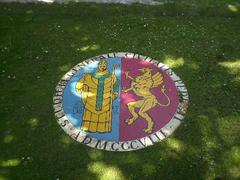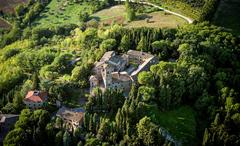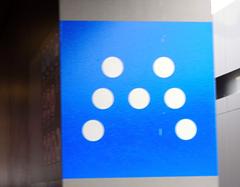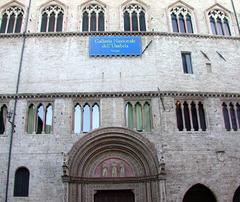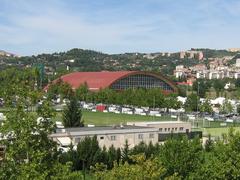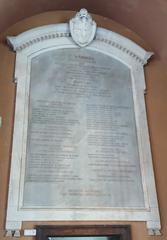
University of Perugia Visiting Guide: Tickets, Hours, and Travel Tips
Date: 14/06/2025
Introduction
The University of Perugia (Università degli Studi di Perugia) is one of Italy’s oldest and most distinguished academic institutions, founded in 1308. Nestled amid the medieval streets and Renaissance architecture of Perugia, the university offers an unparalleled blend of historical intrigue, cultural vibrancy, and modern academic life. This guide provides visitors with all the essential details for exploring the university—covering visiting hours, ticketing, guided tours, accessibility, and nearby attractions. Whether you are a history enthusiast, cultural traveler, or prospective student, the University of Perugia invites you to experience centuries of academic tradition and urban charm. For the latest updates, consult the official University of Perugia website and reputable tourism portals (Understanding Italy; StandYou).
Contents
- Medieval Origins and Foundation
- Renaissance and Early Modern Developments
- Napoleonic and Modern Transformations
- Campus and Architectural Heritage
- Visiting Information: Hours, Tickets, Tours
- Accessibility and Travel Tips
- Student Life and Local Culture
- Nearby Attractions
- Frequently Asked Questions (FAQ)
- Conclusion and Recommendations
- Call to Action
- Sources
Medieval Origins and Foundation
The University of Perugia’s history began in 1308, when Pope Clement V granted the city the right to establish a Studium Generale through the papal bull “Super Specula.” This elevated Perugia’s preexisting schools to university status, allowing it to confer universally recognized degrees and attract students and scholars from across Europe. Its foundation reflected a broader medieval trend of academic independence, as students from the University of Bologna sought a new intellectual environment in Perugia. (Understanding Italy)
Renaissance and Early Modern Developments
The university flourished during the Renaissance, hosting eminent scholars such as Cino da Pistoia and Luca Pacioli. It became a center for legal and medical studies, influencing both Perugia’s civic life and broader Italian intellectual traditions. The construction of the Sapienza Vecchia in 1362 provided a permanent seat for academic life, with frescoed halls and architectural features that still impress visitors today. (StandYou)
Napoleonic and Modern Transformations
The institution underwent significant reforms during the Napoleonic era and was designated a Free University in 1824 by Pope Leo XII. Following Italian unification in 1861, the university became a state institution governed by the Rector Magnificus and City Council, reflecting the modernization of higher education in Italy. It now boasts a wide range of disciplines—from law and medicine to science and engineering—and is recognized for its research excellence and international collaborations. (StandYou)
Campus and Architectural Heritage
Situated in Perugia’s historic center, the university integrates seamlessly with the city’s medieval, Renaissance, and even Etruscan architecture. Many faculties operate within centuries-old palazzi and convents, such as the Olivetan Convent of Monte Morcino and the Sapienza Vecchia, where visitors can admire Gothic arches, frescoed interiors, and Roman mosaics. The campus is not only a hub of academic activity but also a living museum—each building telling a part of Perugia’s layered history. (Understanding Italy; StandYou)
Visiting Information: Hours, Tickets, Tours
Visiting Hours and Tickets
- Hours: Most historic university buildings and courtyards are accessible Monday to Friday, generally from 9:00 AM to 6:00 PM. Hours may vary during holidays or special academic events.
- Admission: Public areas, such as exterior courtyards and some historic halls, can be visited free of charge. Special exhibitions or guided tours may require tickets—always check the official university website for current details.
Guided Tours
- Availability: Guided tours, which highlight the university’s history, art, and architecture, are offered periodically, especially during cultural events and festivals. Advance booking is recommended through university visitor services or local tourism offices.
- Photography: Allowed in most outdoor spaces; confirm policies for interiors or special exhibitions.
Accessibility and Travel Tips
- Mobility: The campus and city center are characterized by hilly terrain and cobblestone streets. Public escalators, elevators, and the Minimetro (driverless rail) help visitors navigate steep areas. Sturdy footwear is strongly advised.
- Disability Access: Accessibility varies by building; some historic structures have limited wheelchair access. Contact visitor services in advance to plan routes and ensure a smooth visit.
- Transport: Perugia’s train station and the nearby airport (Aeroporto Internazionale dell’Umbria) are well connected to the city center via bus, Minimetro, and taxi. Walking is the best way to explore the university and surrounding attractions.
Student Life and Local Culture
The university hosts a vibrant student population, contributing to Perugia’s dynamic atmosphere. Cafés, trattorias, and gelaterias around Piazza Università and Piazza Fortebraccio are popular with students and visitors alike. The calendar is filled with cultural events—concerts, exhibitions, and festivals—many organized in collaboration with the University for Foreigners and student societies. Notable annual events include:
- Umbria Jazz Festival: July, with performances hosted in university venues.
- Eurochocolate Festival: Autumn, featuring chocolate tastings and workshops.
- International Journalism Festival: Spring, attracting media professionals and students globally.
(Facts.net; The World Was Here First)
Nearby Attractions
Combine your campus visit with these highlights of Perugia:
- Piazza IV Novembre: The city’s central square, home to the 13th-century Fontana Maggiore.
- Palazzo dei Priori: A Gothic palace housing the National Gallery of Umbria and municipal museums.
- Cattedrale di San Lorenzo: Gothic cathedral with an attached museum.
- Etruscan Well (Pozzo Etrusco): An ancient marvel of engineering.
- Botanical Gardens: Located near Porta San Costanzo, perfect for a tranquil stroll.
- Rocca Paolina: A fortress with underground passages and exhibitions.
- Assisi and Lake Trasimeno: Ideal for day trips from Perugia.
(Italia.it; Along Dusty Roads)
Frequently Asked Questions (FAQ)
Q: What are the University of Perugia visiting hours?
A: Historic buildings and courtyards are generally open weekdays from 9:00 AM to 6:00 PM. Check the official website for the latest updates.
Q: Are tickets required to visit?
A: Most areas are free to access; tickets may be needed for special exhibitions or guided tours.
Q: Can I book a guided tour?
A: Yes, tours are available during certain periods and events. Booking in advance is recommended.
Q: Is the campus accessible for visitors with disabilities?
A: Some buildings have limited access. Contact visitor services before arrival.
Q: How do I get to the university from the train station?
A: Take the Minimetro to the historic center, then walk or use public escalators to reach university buildings.
Q: Is photography allowed?
A: Usually permitted outdoors; always check policies inside buildings and exhibitions.
Conclusion and Recommendations
A visit to the University of Perugia is a journey through centuries of academic excellence, architectural splendor, and vibrant city life. The university’s integration into Perugia’s historic center offers an immersive experience—explore medieval halls, join a guided tour, or simply enjoy the student energy in the piazzas. Pair your campus visit with nearby landmarks for a deeper understanding of Umbria’s cultural heritage. For a seamless experience, wear comfortable shoes, plan routes in advance, check accessibility if needed, and consult current schedules online.
Call to Action
Ready to experience the University of Perugia and its historic surroundings? Download the Audiala app for exclusive maps, audio guides, and up-to-date visitor information. Stay connected with us on social media for travel inspiration and updates on Perugia’s top attractions. Start planning your memorable visit today!
Tip: For high-quality images and virtual tours of university sites and Perugia’s historic landmarks, visit the university’s official visitor page and local tourism websites. Use descriptive alt tags such as “University of Perugia historic building” or “View of Piazza IV Novembre” to enhance accessibility.
Sources and Further Reading
- Understanding Italy: Perugia
- StandYou: University of Perugia, Italy
- Life in Italy: Perugia City Itinerary
- The World Was Here First: Things to Do in Perugia, Italy
- Facts.net: 48 Facts About Perugia
- Along Dusty Roads: Things to Do in Perugia, Italy
- University of Perugia Official Website: History
- Italia.it: Perugia Guide – History & Facts
